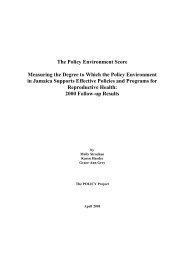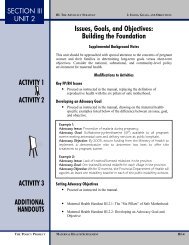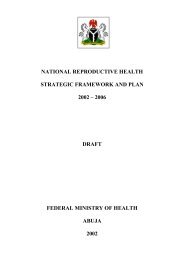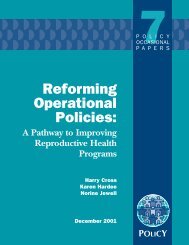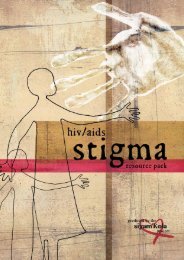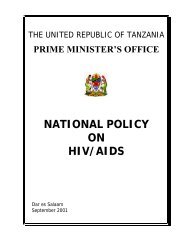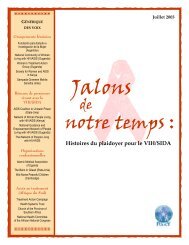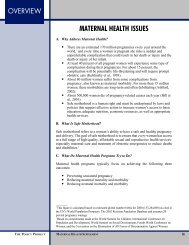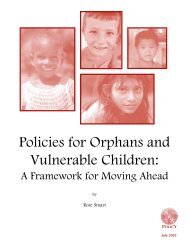THE OVC RAAAP FINAL REPORT - POLICY Project
THE OVC RAAAP FINAL REPORT - POLICY Project
THE OVC RAAAP FINAL REPORT - POLICY Project
Create successful ePaper yourself
Turn your PDF publications into a flip-book with our unique Google optimized e-Paper software.
Executive Summary<br />
<strong>OVC</strong> <strong>RAAAP</strong> Initiative Final Report<br />
Rapid Country Assessment, Analysis, and Action Planning (<strong>RAAAP</strong>) Initiative<br />
On Behalf of Orphans and Other Vulnerable Children in Sub-Saharan Africa<br />
Prepared by <strong>POLICY</strong> <strong>Project</strong><br />
In support of the <strong>OVC</strong> <strong>RAAAP</strong> Initiative, USAID, UNICEF, UNAIDS, and WFP<br />
January 2005
The <strong>POLICY</strong> <strong>Project</strong> is funded by the U.S. Agency for International Development (USAID) under<br />
Contract No. HRN-C-00-00-00006-00, beginning July 7, 2000. <strong>POLICY</strong> is implemented by the Futures<br />
Group in collaboration with the Centre for Development and Population Activities (CEDPA) and<br />
Research Triangle Institute (RTI). The views expressed in this paper do not necessarily reflect those of<br />
USAID.
Contents<br />
Rationale for the <strong>OVC</strong> <strong>RAAAP</strong> Initiative ................................................................................................1<br />
Methodology ................................................................................................................................................2<br />
Overview of Key Findings from <strong>OVC</strong> Desk Reviews ..............................................................................4<br />
Historical Context of Government and Donor Response to HIV/AIDS and <strong>OVC</strong> .............................11<br />
Overview of Global Donor Funding for HIV/AIDS and <strong>OVC</strong> .............................................................12<br />
iii
Rationale for the <strong>OVC</strong> <strong>RAAAP</strong> Initiative<br />
In November 2003, USAID, UNICEF, UNAIDS, and the World Food Program (WFP) launched the<br />
massive orphans and other vulnerable children (<strong>OVC</strong>) Rapid Country Assessment, Analysis, and Action<br />
Planning (<strong>RAAAP</strong>) Initiative in partnership with in-country donor offices, national <strong>OVC</strong> steering<br />
committees, and the <strong>POLICY</strong> <strong>Project</strong> to assess current levels of support and care for children who have<br />
been orphaned or made vulnerable by AIDS in 17 sub-Saharan countries. These countries are Botswana,<br />
Central African Republic, Côte d’Ivoire, Ethiopia, Kenya, Lesotho, Malawi, Mozambique, Namibia,<br />
Nigeria, Rwanda, South Africa, Swaziland, Tanzania, Uganda, Zambia, and Zimbabwe. Twelve of these<br />
countries are slated to receive funding from the President’s Emergency Plan for AIDS Relief.<br />
The <strong>RAAAP</strong> Initiative on behalf of Orphans and Other Vulnerable Children in Sub-Saharan Africa was<br />
an unprecedented effort to identify and analyze the range of services being provided to an estimated 10.6<br />
million children (up to age 17) orphaned by AIDS in the aforementioned 17 countries. The countries were<br />
selected had large numbers of <strong>OVC</strong>. In 11 of these countries, more than 15 percent of all children under<br />
the age of 17 were orphans in 2003. The estimated total number of orphans in the 17 countries was 26.7<br />
million in 2003 (Children on the Brink, 2004).<br />
The underlying imperative for this work is founded on the realization by donor partners and a broad range<br />
of stakeholders that the increasing scale of the HIV/AIDS pandemic is also becoming a rapidly escalating<br />
disaster for children. It is analogous to a “perfect storm” scenario. The HIV pandemic is colliding with<br />
ineffective prevention, infringements on women and children’s human rights, deepening poverty, and<br />
crippled public infrastructures. These conditions are unraveling family and community “safety nets” and<br />
are causing multiple burdens of grief, economic insecurity, and caregiver overload and burnout.<br />
Most of the orphans worldwide who have lost one or both parents to AIDS live in sub-Saharan Africa.<br />
Child-headed households are becoming more prevalent, and frightened children are supporting and<br />
nursing sick parents and caregivers rather than attending school and experiencing a normal childhood.<br />
Millions more children are vulnerable to sexual exploitation and child labor, with growing numbers of<br />
street children and child prostitutes. Moreover, an estimated 3 million children worldwide are living with<br />
HIV/AIDS.<br />
In June 2001, nearly 50 countries signed the United Nations General Assembly Special Session<br />
(UNGASS) Declaration of Commitment on HIV/AIDS, which includes a core set of indicators applicable<br />
to <strong>OVC</strong>. Following an April 2003 report of the Special Envoy of the Secretary General on Humanitarian<br />
Needs in Southern Africa, UNICEF convened the Inter-Agency Task Team on Orphans and Other<br />
Vulnerable Children to bring together a broad coalition of stakeholders to reach consensus on a set of 10<br />
core <strong>OVC</strong> indicators to measure national progress in improving the welfare of <strong>OVC</strong>. The First Global<br />
<strong>OVC</strong> Partners Forum was held in October 2003, and an agreement was reached for greater collaboration<br />
to rapidly scale up and improve the quality of the response to <strong>OVC</strong>. The significance of the <strong>OVC</strong><br />
earmarks for the African countries within the President’s Emergency Plan was also highlighted during<br />
this forum. Subsequently, USAID, UNICEF, UNAIDS, and the WFP outlined objectives to conduct a<br />
rapid assessment exercise in order to scale up the response to <strong>OVC</strong>.<br />
In July 2004, UNICEF, UNAIDS, and a broad range of representatives from other donor and government<br />
agencies, faith-based and nongovernment organizations (NGOs), academic institutions, the private sector,<br />
and civil society collaborated to develop The Framework for the Protection, Care, and Support of<br />
Orphans and Vulnerable Children Living in a World with HIV and AIDS. The five strategies within The<br />
Framework represent an agreed-upon common agenda to support and guided the analysis of the findings<br />
from the <strong>OVC</strong> <strong>RAAAP</strong> Initiative.<br />
1
Methodology<br />
The <strong>OVC</strong> <strong>RAAAP</strong> Initiative was developed as a means for providing a policy and programmatic<br />
framework that would unify and scale up multisectoral national responses to the orphan crisis in each of<br />
the 17 countries in sub-Saharan Africa. The partner agencies designed an approach to rapidly obtain<br />
baseline data for planning and monitoring scale-up in each of the 17 countries participating in the <strong>OVC</strong><br />
<strong>RAAAP</strong> Initiative. The partners included: headquarter and in-country offices of USAID, UNICEF,<br />
UNAIDS, and WFP; <strong>POLICY</strong> <strong>Project</strong>/Futures Group headquarter and field staff; national ministries and<br />
other implementing agencies; and national <strong>OVC</strong> steering committees. The methodology has two<br />
components: development of assessment tools to undertake a “rapid assessment,” followed by analysis<br />
and action planning.<br />
Assessment Tools: Five assessment tools were developed by USAID and UNICEF headquarters to<br />
provide inputs to national <strong>OVC</strong> steering committees engaged in <strong>OVC</strong> action planning. Each national<br />
<strong>OVC</strong> steering committee validated all tools/data at each step of the assessment. The assessment tools are<br />
described below.<br />
1. Situation of <strong>OVC</strong> – An analysis and summary of existing quantitative data was prepared for each<br />
country by USAID/UNICEF staff.<br />
2. Contextual Assessment – This provided an overview of factors shaping the lives (and needs) of <strong>OVC</strong><br />
and families affected by HIV/AIDS. It highlighted the main factors affecting the abilities of<br />
governments, communities, and individuals to respond, including social, political, geographical, and<br />
economic factors, challenges, and opportunities.<br />
3. Response Assessment/<strong>OVC</strong> Desk Reviews – This component of the assessment was prepared by<br />
<strong>POLICY</strong> <strong>Project</strong> for USAID. It detailed the current <strong>OVC</strong> interventions and service response to date,<br />
identifying those providing services/implementing programs, funding and collaborating partners,<br />
geographic and numerical coverage currently being achieved, the cost of service provision, and the<br />
timeframe and duration of current interventions. The response data were used to provide an<br />
assessment of the overall adequacy of interventions at the country level, including program<br />
effectiveness, barriers to scale up, and cost-effectiveness.<br />
The <strong>OVC</strong> Desk Reviews were systematic searches for <strong>OVC</strong> intervention descriptions and evaluations<br />
relevant to each of the 17 countries, using the following sources of data:<br />
• Descriptive and analytical <strong>OVC</strong> studies and reports from international donors, including annual<br />
reports, research documents, presentations, and situational analyses.<br />
• Electronic databases of project descriptions and workplans from website searches of major<br />
international nongovernmental organizations (NGOs) and community-based organizations.<br />
• Literature searches for “grey literature” not formally published, including program and project<br />
reports, policy documents, conference abstracts, and news articles.<br />
• Email correspondence with project staff identified in each country.<br />
The desk reviews did not include direct collection of final project reports and evaluations from<br />
implementing organizations or various international donor organizations active in the 17 countries.<br />
Most important, they did not include direct field observations that would be necessary to most<br />
accurately characterize appropriateness, relevance, effectiveness, and program factors enabling or<br />
2
constraining intended <strong>OVC</strong> intervention outcomes. This information about current <strong>OVC</strong> responses is<br />
a unique data set, the first of its kind collected since the beginning of the epidemic.<br />
4. <strong>OVC</strong> Effort Index – An assessment of each country’s commitment and level of effort toward<br />
accomplishment of the five UNGASS <strong>OVC</strong>-related goals was conducted among national <strong>OVC</strong><br />
steering committee members by local consultants with assistance from <strong>POLICY</strong> <strong>Project</strong>. The survey<br />
served as a self-assessment of progress among key partners and stakeholders engaged in each<br />
country’s national response on behalf of <strong>OVC</strong>. It is a self-report of national effort to date.<br />
5. Community Responses – This assessment provided information about existing community responses<br />
to <strong>OVC</strong>, as extended families and communities provide the majority of support to <strong>OVC</strong>. It included<br />
identification of ways to strengthen the capacity of families affected by HIV/AIDS to respond to<br />
<strong>OVC</strong> and to participate in a comprehensive national response.<br />
Unit costs of essential services were measured separately with a 23-country UNICEF-funded survey.<br />
Local consultants interviewed major <strong>OVC</strong> service organizations in each country in order to collect cost<br />
data for components of each major <strong>OVC</strong> service area—food, healthcare, psychosocial support, financial<br />
aid/economic stability, education, and legal protections. The data captured unit costs among small and<br />
large organizations in both urban and rural settings. It is the first data set of its kind.<br />
Analysis and Action Planning: The input, process, and output data gathered and summarized within<br />
each of the five assessment tools were delivered to each national <strong>OVC</strong> steering committee for validation<br />
and analysis. In some instances, in-country consultants confirmed or added information to each tool and<br />
prepared analytic reports as a preface to action planning. The national <strong>OVC</strong> steering committees then<br />
prepared national <strong>OVC</strong> action plans to set priorities and identify financial and technical support for rapid<br />
scale-up of <strong>OVC</strong> efforts. The assessment tools and process also provided a framework for enabling<br />
countries to collect, assess, and routinely update their own data, and to make much needed improvements<br />
to their <strong>OVC</strong>-specific tracking and monitoring and evaluation systems.<br />
One of the outcomes of the analysis phase was to support national ownership of results and help to<br />
mobilize commitment to a scaled-up response on behalf of <strong>OVC</strong>. As a result of this investigation,<br />
governments are specifically using data from the <strong>OVC</strong> Desk Reviews to inform further development and<br />
implementation of draft or final orphan policies, and national <strong>OVC</strong> steering committees have integrated<br />
<strong>OVC</strong> Desk Review data into 16 of 17 national <strong>OVC</strong> action plans that identify key actions and priorities for<br />
addressing current gaps and constraints in programming scaled-up responses to <strong>OVC</strong>.<br />
3
Overview of Key Findings from <strong>OVC</strong> Desk Reviews<br />
The major findings from the <strong>OVC</strong> <strong>RAAAP</strong> process directly link to the five strategies of The Framework<br />
for the Protection, Care, and Support of Orphans and Vulnerable Children Living in a World with HIV<br />
and AIDS. The results of the <strong>OVC</strong> Desk Reviews, along with the <strong>OVC</strong> Effort Index findings and <strong>OVC</strong><br />
unit cost data, provide groundbreaking baseline information, but much work remains to be done to set<br />
priorities and operationalize <strong>OVC</strong> programs, cost and allocate resources, and implement the national<br />
<strong>OVC</strong> action plans.<br />
Preparation of the 17 <strong>OVC</strong> Desk Reviews was the first undertaking of its kind to identify the number of<br />
<strong>OVC</strong> (including children in need and children orphaned or made vulnerable by HIV/AIDS) receiving or<br />
not receiving essential services and support across all 17 countries. Each <strong>OVC</strong> Desk Review summarizes<br />
project interventions and support provided by stakeholders at every level within the following major <strong>OVC</strong><br />
service areas: food/nutrition, education, healthcare, psychosocial care and counseling, child protection,<br />
financial assistance, and other supportive services. In addition to providing baseline information critical<br />
for strategic <strong>OVC</strong> programming, the effort tracked <strong>OVC</strong> program funding streams and the status of<br />
development of national <strong>OVC</strong> policies and strategic plans, identified organizations at all levels that are<br />
directly delivering services to <strong>OVC</strong>, and evaluated the quality of these services and key factors for rapidly<br />
scaling up the scope of services/support and coverage.<br />
The collective findings from the <strong>OVC</strong> Desk Reviews are the most current, evidence-based data available<br />
for analyzing the scope, coverage, and quality of each national response to <strong>OVC</strong>. The 17-country findings<br />
provide a unique reference for stakeholders involved in planning or implementing <strong>OVC</strong> and HIV/AIDS<br />
programs. The country-specific data can be found at www.futuresgroup.com/ovc. Additional data and<br />
verification can be obtained by directly contacting each National <strong>OVC</strong> Steering Committee. The main<br />
findings of the <strong>OVC</strong> Desk Reviews are presented below using The Framework for the Protection, Care,<br />
and Support of Orphans and Vulnerable Children Living in a World with HIV and AIDS and its<br />
accompanying strategies as a way of illustrating progress to date in achieving the UNGASS <strong>OVC</strong> goals.<br />
Framework Strategy #1: Strengthen the capacity of families to protect and care for orphans and<br />
vulnerable children by prolonging the lives of parents and providing economic, psychosocial, and<br />
other support.<br />
Prevention of HIV infection and progression to AIDS is central to avoiding future increases of the number<br />
of orphans due to AIDS (from the 10.6 million <strong>OVC</strong> due to AIDS currently identified in the 17 <strong>OVC</strong><br />
Desk Reviews to an estimated 25 million <strong>OVC</strong> projected over the next decade). One obvious strategy for<br />
reducing the numbers of orphans due to AIDS is to reduce the number of infections among adults. Yet<br />
based on evidence from the <strong>OVC</strong> Desk Reviews, the most prominent sources of global HIV/AIDS funds<br />
appear to give priority to treatment of adults and children living with HIV/AIDS rather than to more<br />
aggressive HIV prevention tactics. Both approaches are necessary, and funding for both must be<br />
appropriately balanced.<br />
Many <strong>OVC</strong> are themselves living with AIDS. Depending on a given country’s definition of <strong>OVC</strong>, some<br />
<strong>OVC</strong> may also be sexually active and thus particularly vulnerable to infection. In the context of the<br />
growing economic and social risks the <strong>OVC</strong> crisis presents to national and global security, it is clear that<br />
age-specific HIV prevention programs must be established and accessible to the most vulnerable youth. It<br />
is essential that <strong>OVC</strong> guardians and caregivers have access to all aspects of prevention education and<br />
services. This includes the enforcement of women’s and children’s education and economic rights,<br />
particularly inheritance rights.<br />
4
Key Findings:<br />
• Evidence across all 17 <strong>OVC</strong> Desk Reviews indicates an urgent need for more effective HIV<br />
prevention at the school and community levels. In Botswana, for example, a needs assessment for<br />
HIV prevention in the schools found that 74 percent of staff felt that materials were not relevant or<br />
target-specific and teachers were not adequately trained.<br />
• Data from all 17 countries indicate that men are typically more informed and educated about<br />
HIV/AIDS and prevention methods than women. This is likely because sub-Saharan Africa is<br />
lagging behind all other regions of the world in numbers of girls enrolled in school. High HIV<br />
prevalence rates among pregnant women in a number of sub-Saharan African countries (e.g.,<br />
Swaziland and Lesotho) are predictors of much larger orphan populations in the near future.<br />
Indicators of this trend are the much higher rates of HIV infection among females aged 15–24 in<br />
most of these countries and the fact that the incidence of HIV infection among teenage women is five<br />
times higher than among teenage men.<br />
• Evidence from all of the <strong>OVC</strong> Desk Reviews pointed to a severe shortage of economic or<br />
psychosocial support programs and poor service coverage for <strong>OVC</strong> caregivers. The vast majority of<br />
these caregivers are females, many of them elderly, most of them supporting themselves, orphans,<br />
and other children on less than US$1 a day. The severe poverty among female-headed households<br />
who are caring for orphans is directly linked to illiteracy and cultural and civil prohibitions against<br />
women and children inheriting wealth and property.<br />
• There is substantial evidence that the financial and physical burden of caring for persons living with<br />
HIV/AIDS and orphans falls on already-impoverished households. For instance, in Kenya, 45<br />
percent of all HIV/AIDS-related expenditures (assumed to include orphan care) are paid as direct<br />
out-of-pocket expenses by households, whereas the government of Kenya pays for 30 percent and<br />
donors pay for the other 25 percent (Kenya HIV/AIDS National Health Accounts Subanalysis, 2004).<br />
Given the increasing poverty as a result of rising household healthcare expenditures throughout<br />
Africa, community-driven interventions and direct assistance to households must be incorporated<br />
into national <strong>OVC</strong> action plans and budgets.<br />
• Families and communities have long been regarded as the “safety nets” for sustainable response to<br />
the epidemic, including the <strong>OVC</strong> crisis. Yet, according to the <strong>OVC</strong> Desk Reviews, caregivers in all<br />
17 countries reported that without immediate and direct financial support, orphan and other<br />
children’s access to food, healthcare, and education—including prevention education—will continue<br />
to deteriorate.<br />
Lesson Learned: HIV prevention approaches should be central to poverty reduction strategies.<br />
The large and growing orphan populations in all 17 countries indicate that current HIV prevention efforts<br />
among <strong>OVC</strong> (and adults) are not working. Not one of the <strong>OVC</strong> <strong>RAAAP</strong> countries is economically,<br />
logistically, or legally prepared to cope with the rising numbers of <strong>OVC</strong>. Decreased incidence of orphans<br />
can only be achieved by giving priority to <strong>OVC</strong> HIV prevention and integrating HIV prevention within all<br />
other <strong>OVC</strong> support and services and into ongoing activities such as antiretroviral therapy, prevention of<br />
mother-to-child transmission, and voluntary counseling and testing services.<br />
The global donor community has projected that by 2007, US$1 billion will be needed annually for AIDS<br />
orphanages globally (UNAIDS), an approach that is antithetical to the family and community-based<br />
strategies recommended by The Framework. At the same time, billions of dollars are being earmarked to<br />
5
provide drug access and treatment to those already infected and living with HIV/AIDS. Effective HIV<br />
prevention––including sustainable job creation programs––among adults and children should also be a<br />
major priority of every government and donor engaged in the fight against AIDS. The resiliency of<br />
communities (and the stability of grassroots democracies) is eroding under the combined onslaught of the<br />
HIV epidemic, drought, and escalating poverty, placing an even greater burden on households and<br />
community volunteers caring for more and more orphans and children in need. Donors cannot assume that<br />
“volunteerism” at the community level is a long-term, sustainable strategy. Funds need to be invested in<br />
community-led <strong>OVC</strong> initiatives that create jobs, educational access, and provide cash grants to female<br />
heads of households. A mix of economic incentives must be provided to meet the varied short- and longterm<br />
needs of households and communities: cash grants, conditional cash grants, microfinance, direct<br />
emergency financial aid, job creation, funds to pay community outreach workers and caregivers, and<br />
seeds for food crops.<br />
School and community-based HIV prevention education programs must be tailored to meet the age,<br />
gender, and developmental needs and specific vulnerabilities of each at-risk constituency. While<br />
abstinence, faithfulness, and condoms can help prevent HIV infections, so, too, can the improved<br />
economic status of <strong>OVC</strong> and their caregivers. Economic stabilization at the family and community levels<br />
is among the most effective and least-funded HIV prevention strategies in the sub-Saharan region.<br />
Framework Strategy #2: Mobilize and support community-based responses (to provide both<br />
immediate and long-term support to vulnerable households).<br />
The <strong>OVC</strong> Desk Reviews repeatedly confirmed that communities continue to be the mainstays of the <strong>OVC</strong><br />
response. In the vast majority of countries surveyed, communities provide far more <strong>OVC</strong> services and<br />
direct support than government ministries, donors, or international nongovernmental organizations<br />
(INGOs) combined (see draft Country Rapid Response tables at www.futuresgroup.com/ovc for detailed<br />
implementing partner activities). <strong>OVC</strong> Desk Reviews in all 17 countries reported that NGOs and<br />
caregivers cited severe funding and staffing shortages and a lack of national <strong>OVC</strong> guidelines as major<br />
impediments to scaling up and sustaining community-based efforts.<br />
Key Findings:<br />
• The <strong>OVC</strong> Desk Reviews frequently found that <strong>OVC</strong> policies were not integrated into national poverty<br />
alleviation plans, national HIV/AIDS strategic plans and policies, or human rights frameworks. To<br />
implement national <strong>OVC</strong> action plans, funds must be earmarked for community-based <strong>OVC</strong><br />
programs within the national AIDS budget and included in proposals to the Global Fund for AIDS,<br />
Tuberculosis and Malaria (GFATM) and other donors.<br />
• Government ministries coordinating a national <strong>OVC</strong> response often reported that they were unable to<br />
orchestrate the complex activities required to involve and reach the community level. Global and<br />
national <strong>OVC</strong> response efforts are often hampered by staff shortages, insufficient resources and<br />
technology to increase capacity, and reluctance among fiscally competitive <strong>OVC</strong> providers at all<br />
levels to share information and “best practices.” Though community-centered coordination is more<br />
labor- and resource-intensive, it is necessary to rely on and partner with communities during strategic<br />
planning, priority setting and resource allocation, and monitoring and evaluation.<br />
• Compensating family and community <strong>OVC</strong> caregivers is one way of securing the growth of<br />
programs and guaranteeing <strong>OVC</strong> access to basic essential services such as food, healthcare, and<br />
education. Job creation through financial compensation for formerly unpaid female volunteer labor at<br />
the community level is essential to building a secure national and local <strong>OVC</strong> response mechanism.<br />
6
Lesson Learned: Investing in community-centered infrastructure while expanding government<br />
services at the community level improves care and support to children.<br />
Families and communities—particularly women—have expertise in identifying and responding to the<br />
needs of <strong>OVC</strong>. It seems evident, therefore, that national <strong>OVC</strong> strategic planning and resource allocation<br />
must be centered at the community level.<br />
Capitalizing on communities’ and caregivers’ <strong>OVC</strong> knowledge is a smart financial strategy that will<br />
guarantee stronger returns on dollars invested. This includes bolstering existing community <strong>OVC</strong><br />
programs, community-based children’s care centers, and other mechanisms by building staff and program<br />
capacity around the already-existing nuclei of response found in community after community. Equally as<br />
important, it means integrating poverty reduction strategies focused on community economic vitality with<br />
an <strong>OVC</strong> policy and national HIV/AIDS goals that also recognize communities as principal beneficiaries<br />
and implementing forces.<br />
A functioning and vital <strong>OVC</strong> sector represents an incredible opportunity for democratic and economic<br />
stabilization throughout the region. It should be strengthened by focusing donor funds and expanding<br />
government services for <strong>OVC</strong>, while reducing poverty at the community level by generating <strong>OVC</strong> sector<br />
jobs. For instance, local community <strong>OVC</strong> care coordinators could be hired to track individual <strong>OVC</strong> cases<br />
and households with children in need, to improve data collection, and to monitor the quality of <strong>OVC</strong><br />
support services and delivery mechanisms. Hiring from within the community and coordinating<br />
government services with community-led initiatives would help boost the local economy while<br />
reinforcing a deep sense of community ownership for <strong>OVC</strong> support and programming.<br />
Framework Strategy #3: Ensure access for <strong>OVC</strong> to essential services, including education,<br />
healthcare, and birth registration.<br />
Unfortunately, despite great efforts on the part of governments, donors, INGOs, and local NGOs, the<br />
<strong>OVC</strong> Desk Reviews found that only a small percentage of vulnerable children were receiving even one<br />
basic service. It is possible that these low figures are as much a reflection of poor monitoring and<br />
evaluation systems found across all 17 countries as they are true assessments of the number of <strong>OVC</strong><br />
receiving services. Regardless, these are the most comprehensive coverage numbers to date, and they<br />
indicate extremely low numbers of <strong>OVC</strong> currently receiving services, support, and other assistance.<br />
Key Findings:<br />
• Out of an estimated 10.6 million children orphaned and made vulnerable by AIDS in sub-Saharan<br />
Africa, it is estimated that 914,000 are receiving even one essential service, such as food, healthcare,<br />
education, psychosocial support, or protection. This means that only 8.6 percent of the total<br />
estimated number of orphans and vulnerable children due to AIDS are receiving at least one essential<br />
service.<br />
• In a number of <strong>OVC</strong> <strong>RAAAP</strong> countries, <strong>OVC</strong> Desk Reviews found that donors, governments, and<br />
NGOs were unable to track how many <strong>OVC</strong> were receiving services and support or how much<br />
money was earmarked for them. This was due in part to decisions made to protect orphans from<br />
stigma and discrimination by merging assistance funds for <strong>OVC</strong> into such general aid categories as<br />
HIV/AIDS, Children, and Youth. However, findings of such poor coverage call into question how<br />
effectively children and youth are being prioritized within national HIV/AIDS plans and how well<br />
human rights covenants are genuinely being upheld.<br />
7
• Across all 17 countries, lack of high-quality birth and death registration systems make it difficult for<br />
orphans to obtain official records “proving” they are orphans. As a result, millions of <strong>OVC</strong> are<br />
ineligible to receive public benefits such as food aid or free medical care or primary education. And<br />
million of orphans are not able to claim property and other inheritance rights that could provide<br />
access to education and some modicum of economic security.<br />
Lesson Learned: Establish monitoring and evaluation systems to track fiscal and program<br />
outcomes to ensure reversals of low <strong>OVC</strong> coverage.<br />
Many factors have contributed to the low <strong>OVC</strong> coverage numbers across sub-Saharan Africa. These range<br />
from poor monitoring and evaluation on the part of governments, donors, and NGOs to shortages in<br />
<strong>OVC</strong>-specific funds, poor fiscal tracking and logistical coordination, and deficits in staff numbers and<br />
capabilities. Despite these findings, it is important to recognize that these severe service and support gaps<br />
can be closed. Donors can play an important role by funding capacity building and training that will<br />
enhance community-based <strong>OVC</strong> providers’ administrative, financial, and service delivery skills. Donors<br />
can also require that funding to both governments and NGOs be contingent upon evidence-based<br />
improvements in fiscal accountability and in numbers of <strong>OVC</strong> reached. Governments can improve <strong>OVC</strong><br />
coverage rates by providing greater support to ministries responsible for <strong>OVC</strong> coordination.<br />
Framework Strategy #4: Ensure that governments protect the most vulnerable children through<br />
improved policy and legislation and by channeling resources to communities.<br />
The <strong>OVC</strong> Desk Reviews found that across all 17 countries surveyed, governments lagged behind in<br />
enforcing child protection and human rights laws. These gaps in protection make <strong>OVC</strong> and their<br />
caregivers more susceptible to poverty and to stigma and discrimination, including being barred from<br />
accessing public <strong>OVC</strong> benefits.<br />
Key Findings:<br />
• The <strong>OVC</strong> Desk Reviews found that many governments excelled at signing commitments to such<br />
international agreements as the Convention on the Rights of the Child, the Convention on the<br />
Elimination of All Forms of Discrimination Against Women, the International Labor Union’s<br />
Convention on Child Labor, and the African Unity’s Charter on the Welfare and Rights of the Child.<br />
Glaring gaps, however, remain in the area of enforcement of these laws.<br />
• Many governments reported that poor enforcement was linked to severe funding strategies and lack<br />
of trained staff. It was not clear from the <strong>OVC</strong> Desk Reviews how many donors are making funds<br />
conditional on enforcement of women’s and children’s human rights.<br />
• Lack of enforcement of women’s and children’s human rights is threatening the well-being of<br />
orphans and their caregivers, particularly as it relates to inheritance rights. With no legal right to<br />
claim wealth or property, women and children plunge deeper into poverty. This, in turn, increases<br />
their chances of being exploited, sexually assaulted, or infected with HIV.<br />
• This lack of enforcement severely inhibits government and donor efforts to channel resources to<br />
communities, particularly to women and girls who provide the vast majority of <strong>OVC</strong> care but who<br />
are often too poor and disenfranchised to afford basic services such as food, healthcare, or education.<br />
8
Lesson Learned: Create a multisectoral fiscal “checks and balances” system; require that funding<br />
be contingent on evidence-based human rights enforcement.<br />
Donors can accelerate enforcement of women’s and children’s human rights by requiring that funding<br />
streams be contingent upon evidence-based progress on issues of gender equity and human rights. To<br />
achieve scale-up, donors can also insist that funds be tied to systems that can rapidly replicate “best<br />
practices” and reinforce a shared learning environment among <strong>OVC</strong> providers.<br />
At the same time, donors can play a much larger role in improving fiscal tracking of <strong>OVC</strong> funds. Based<br />
on evidence collected through the <strong>OVC</strong> Desk Reviews, it appears that a multisectoral system of fiscal<br />
checks and balances is missing from most of the countries surveyed. Such a system needs to be rapidly<br />
adopted by donors, governments, and NGOs. Currently, it appears that while donor funds may in fact be<br />
allocated for <strong>OVC</strong> services, in many cases there is no evidence or follow-up to determine how that money<br />
has been spent or how many <strong>OVC</strong> have benefited. In other cases, <strong>OVC</strong> funds are not earmarked but are<br />
merged into much broader aid categories such as HIV/AIDS or youth, and it cannot be ascertained<br />
whether <strong>OVC</strong> were, in fact, served.<br />
Framework Strategy #5: Raise awareness at all levels through advocacy and social mobilization to<br />
create a supportive environment for children and families affected by HIV/AIDS.<br />
Few of the 17 countries surveyed have conducted campaigns to educate the public about the dimensions<br />
of the national <strong>OVC</strong> crisis, national <strong>OVC</strong> policies, or child protections.<br />
Key Findings:<br />
• The scarcity of concrete advocacy campaigns may be partly due to the fact that eight of 17<br />
governments have not yet completed national <strong>OVC</strong> policies, and seven of 17 have not completed<br />
national <strong>OVC</strong> strategic plans. Thus, there are no benchmarks or guiding principles to report to their<br />
citizens.<br />
• In other cases, governments are not fiscally or logistically equipped to conduct such massive<br />
education initiatives among the public––or even among government workers. For instance, the 2003<br />
Survey on the Prevalence and Characteristics of AIDS Orphans in Ethiopia found that even when an<br />
HIV/AIDS or <strong>OVC</strong> policy does exist, government workers are not necessarily well informed or<br />
aware of its existence. The survey found that one of five government officials are unaware that a<br />
national HIV/AIDS policy exists, and 40 percent of organizations interviewed reported they do not<br />
have any plan of action designed to render services to AIDS orphans.<br />
Lesson Learned: <strong>OVC</strong> will be given priority when governments create a separate <strong>OVC</strong> ministry or<br />
<strong>OVC</strong> ombudsman to represent the interests and needs of <strong>OVC</strong>.<br />
In all of the 17 countries surveyed, <strong>OVC</strong> and their special needs continue to be marginalized. Extremely<br />
low coverage numbers confirm this phenomenon.<br />
Governments are making efforts to address <strong>OVC</strong> by designating one or several government ministries to<br />
conduct studies, establish <strong>OVC</strong> task forces and national <strong>OVC</strong> steering committees, and coordinate and<br />
support community-based activities. More often than not, however, the <strong>OVC</strong> Desk Reviews found that<br />
these ministries are often too busy with other responsibilities to fully devote attention and limited human<br />
and financial resources to the myriad needs of <strong>OVC</strong>. In many cases, the delegated ministries are<br />
9
politically and economically weak, understaffed, and overwhelmed with current responsibilities. The<br />
result: large numbers of <strong>OVC</strong> are unable to access even one basic service.<br />
Governments, donors, NGOs, and—most of all—<strong>OVC</strong> and their caregivers, would benefit greatly from<br />
the creation of a national <strong>OVC</strong> ministry or a national <strong>OVC</strong> ombudsman. Such a ministry or post would<br />
establish one clear advocate, one central information clearinghouse, and specific policy and funding on<br />
behalf of <strong>OVC</strong>. It would provide one representative office that could convene multisectoral input to<br />
coordinate with the array of donor agencies. It would promote stronger adherence to program and funding<br />
accountability and would ensure that more <strong>OVC</strong> and their caregivers receive the services they deserve. In<br />
addition, a national <strong>OVC</strong> ministry or national <strong>OVC</strong> ombudsman could work to ensure that <strong>OVC</strong> are<br />
specified within poverty reduction strategies and funding sources, as well as national HIV/AIDS<br />
programs. Organizationally, an <strong>OVC</strong> advocate or representative office could ensure the inclusion of the<br />
community and civil society—including children in need, orphans, and caregivers—in every phase of<br />
<strong>OVC</strong> strategic planning, implementation, and evaluation.<br />
10
Historical Context of Government and Donor Response to HIV/AIDS and <strong>OVC</strong><br />
Many of the <strong>OVC</strong> Desk Review findings paint a bleak reality of neglect toward children orphaned and made<br />
vulnerable by the HIV/AIDS epidemic. Yet, the findings also demonstrate how citizens and governments in all<br />
17 countries, so afflicted by poverty, hunger, disease, and—in many cases—war and conflict, are making<br />
concerted efforts to reach <strong>OVC</strong> who are in desperate need of love, care, and support. In reading and<br />
interpreting the findings, it is essential that we examine and place in context the responses made by<br />
governments and donors to the overall pandemic during the last two decades. Through this historical<br />
referencing, we are better able to see how decisions of the past are now influencing the present.<br />
The first cases of AIDS surfaced in Africa in the mid-1980s. At that early stage, national governments and the<br />
international donor community approached AIDS as a public health issue. Given that perspective, ministries of<br />
health in AIDS-affected nations became the chief managers of national coordinated responses. They were also<br />
the principal recipients of early HIV/AIDS funding. Unfortunately, ministries of health have often been among<br />
the least funded and least empowered arms of government.<br />
As the HIV/AIDS pandemic grew, so, too, did government and donors’ understanding of and response to it. As<br />
ministries of health geared up to control the spread of HIV and treat those infected, a broader range of support<br />
was needed to coordinate expanded HIV-prevention programming. At this point, ministries of education also<br />
became involved. Similar to the ministries of health, however, these ministries also experienced severe<br />
shortages in staff, technical capability, funding, and capacity building.<br />
Governments and the international community have only recently begun to cultivate and solidify more<br />
comprehensive, national HIV/AIDS responses through a multisectoral partnership effort. Today in all 17<br />
countries surveyed, those involved in building a response to HIV/AIDS—including the <strong>OVC</strong> crisis—include<br />
governments, donors, INGOs, NGOs, religious and faith-based organizations, community-based organizations,<br />
and grassroots groups. In some countries, caregivers and older orphans are also contributing to program design<br />
and development.<br />
Many positive steps have been taken to control the epidemic and to begin assessing and providing greater<br />
leadership around <strong>OVC</strong>-related issues. However, the early tendency to delegate HIV/AIDS responsibility to<br />
weaker government ministries continues, particularly in the realm of <strong>OVC</strong> care and support. As the <strong>OVC</strong> Desk<br />
Reviews reveal, in many of the 17 countries, the ministry responsible for <strong>OVC</strong> care and support tends to be the<br />
least powerful—for multiple reasons. In Mozambique, for example, where the Ministry of Women is the lead<br />
<strong>OVC</strong> agency, a senior government contact reported that “there is very weak” coordination of <strong>OVC</strong> programs<br />
and confirmed that the Ministry of Women “is one of the least resourced ministries” in the government. This<br />
contact further noted that it is “very hard to find out who, exactly, is or is supposed to be coordinating specific<br />
<strong>OVC</strong> activities.” Parallel examples exist in Malawi and Nigeria, where the Ministry of Gender and Community<br />
Services and the Federal Ministry of Women Affairs and Youth Development, respectively, are the lead<br />
government agencies.<br />
In Malawi, Mozambique, and Nigeria there is little, if any, enforcement of existing women’s and children’s<br />
rights, and legal reforms that could provide greater protections are slowly occurring at best. Given this context<br />
(which is not limited to the aforementioned examples), it is not surprising that national strategies to expand<br />
financial assistance and care and support to <strong>OVC</strong> and their caregivers have not yet reached donor or<br />
government priority lists. In other <strong>OVC</strong> <strong>RAAAP</strong> countries, responsibility for the <strong>OVC</strong> crisis has been<br />
delegated to not just one single ministry, but to three or four. In Zimbabwe, the Ministry of Public Services,<br />
Labor, and Social Affairs, the Ministry of Legal Affairs, and the Ministry of Basic Education, Sports, and<br />
Culture are in charge of all <strong>OVC</strong> coordination. While shared responsibility could potentially lead to achieving<br />
greater coverage for <strong>OVC</strong>, data from the <strong>OVC</strong> Desk Reviews reveal that multiple leaders often appear to<br />
diffuse efforts and produce fragmented outcomes.<br />
11
Overview of Global Donor Funding for HIV/AIDS and <strong>OVC</strong><br />
Many of the <strong>OVC</strong> Desk Review findings reflect deficiencies in government and international responses to<br />
the escalating <strong>OVC</strong> crisis in sub-Saharan Africa. Most of the governments surveyed do not have sufficient<br />
financial resources to holistically address the HIV/AIDS epidemic, including the <strong>OVC</strong> crisis and the<br />
parallel crisis of weak enforcement of women and children’s rights. In other instances, available<br />
government or donor funds are not adequately earmarked for distribution, channeled to communities and<br />
children most in need, or monitored. The findings strongly suggest the need for a paradigm shift by<br />
donors and major stakeholders to channel resources more predictably, efficiently, and effectively to<br />
support community response capacity.<br />
Global donor funds are critical to building caring, legally protective, and supportive environments for the<br />
10.6 million <strong>OVC</strong> due to AIDS identified through the <strong>OVC</strong> Desk Reviews. The following somewhat<br />
limited financial information presents a sketchy context of funding priorities to address the HIV/AIDS<br />
epidemic (most of this information is based on reports compiled by UNAIDS). Yet the evidence shows<br />
that donors, similar to governments, are just beginning to fully address the orphans and children-in-need<br />
crisis in sub-Saharan Africa and other parts of the world.<br />
Financing the Expanded Response to AIDS was prepared in July 2004 by UNAIDS in partnership with<br />
the International Labor Organization, Futures Group, UNDP, UNFPA, the World Bank, and other<br />
prominent international donors. In the report, UNAIDS initially estimated that US$10.5 billion and $15<br />
billion would be needed in 2005 and 2007, respectively, to finance the necessary global HIV/AIDS<br />
response. UNAIDS has since recalculated cost expenditures. It currently estimates that $12 billion will be<br />
needed by 2005 and $20 billion by 2007. It is not clear from either the UNAIDS report or most of the data<br />
gathered during the <strong>OVC</strong> Desk Reviews exactly how much of these sums are being considered for <strong>OVC</strong><br />
care and support.<br />
The UNAIDS projections of future resource needs for orphans are daunting:<br />
• $509 million per year for orphanages globally. By 2007, the needed expenditure is projected to be<br />
more than $1 billion a year.<br />
• Support for communities is estimated at $364 million a year. By 2007, needed support is projected to<br />
be $722 million.<br />
• In 2005, UNAIDS estimated that support to orphans through school fees would require $204 million.<br />
By 2007, the needed expenditure is projected to be $406 million.<br />
The following UNAIDS information gathered through annual mail surveys to donors and recipients is<br />
important for interpreting the findings from the <strong>OVC</strong> Desk Reviews:<br />
• Similar to governments and NGOs, many donor funds are not disaggregated according to “Orphan”<br />
or “<strong>OVC</strong>” categories versus “Children,” or even “General Population” or “General Health<br />
Expenditures.” Global financing tracking reports produced by UNAIDS do not track fiscal spending<br />
for <strong>OVC</strong> categories.<br />
• The President’s Emergency Plan is the world’s newest and largest source of HIV/AIDS funds, with a<br />
pledge of US$15 billion over five years for 12 of the 17 sub-Saharan countries surveyed for the <strong>OVC</strong><br />
<strong>RAAAP</strong> process. Three-fourths of the total Emergency Plan budget is allocated for treatment,<br />
compared with 10 percent that is allocated for <strong>OVC</strong> care and support. Of the $2.4 billion released<br />
12
earlier in 2004 by the U.S. Congress, approximately $240 million is earmarked for <strong>OVC</strong> care and<br />
support.<br />
• The second newest source of significant HIV/AIDS funds is the GFATM. As of June 2002, the<br />
Global Fund had recorded pledges of $1.9 billion. As of July 2004, progress had been made on 25<br />
grants in 15 countries, with a total commitment of $158 million. An estimated $68 million is<br />
earmarked for AIDS. Data are not available to determine exactly how much of these funds are<br />
allocated for—or actually spent on—<strong>OVC</strong> care and support.<br />
• HIV/AIDS expenditures from the WFP increased from $1 million in 2001 to $195 million in 2002. A<br />
majority of the 17 <strong>OVC</strong> <strong>RAAAP</strong> countries in sub-Saharan Africa rely on the WFP funds to support<br />
<strong>OVC</strong> feeding programs. However, it is not clear what portion of these funds have directly reached<br />
<strong>OVC</strong>.<br />
• The World Bank represents the largest source of HIV/AIDS funding to the world’s poorest countries<br />
through its Multicountry AIDS Program (MAP). MAP has spent $1 billion in multiyear grants or<br />
interest-free loans to support HIV/AIDS programs in Southern Africa. It is not clear what portion of<br />
these funds has been allocated for <strong>OVC</strong>-specific activities.<br />
Another UNAIDS report, published in May 2004, summarized donor expenditures for HIV/AIDS. Aid<br />
Activities in Support of HIV/AIDS Control, 2000–2002 (Secretariat of the Development Assistance<br />
Committee of the OECD and UNAIDS) provides a comprehensive overview of aid allocation for<br />
HIV/AIDS activities by donor and recipient countries. Highlights from this document include:<br />
• From 2000 to 2004, Development Assistance Committee members’ commitments to AIDS control<br />
were $2.2 billion per year. It is not clear what portion of these funds were allocated for or reached<br />
<strong>OVC</strong> in the 17 countries surveyed.<br />
• The top 10 bilateral donors provide an estimated $1.1 billion per year for HIV/AIDS control<br />
programs. Allocations to the GFATM total an estimated $1 million per year, although pledges to<br />
GFATM are considerably higher.<br />
• In 2003, the United States provided 35.2 percent, or $577 million, of all global resources for<br />
HIV/AIDS control. Data gathered during the <strong>OVC</strong> Desk Reviews could not distinguish what portion<br />
of this funding was used to care for and support orphans and vulnerable children.<br />
The World Bank’s <strong>Project</strong>s Lending Portfolio includes close to half a billion dollars in credit lines to 10<br />
of the 17 <strong>OVC</strong> <strong>RAAAP</strong> countries surveyed. Other than possibly supporting the establishment of the<br />
national <strong>OVC</strong> steering committees, it is unlikely that these funds are being used for <strong>OVC</strong> activities.<br />
Many of the countries listed below are already classified as heavily indebted poor countries (HIPC), a<br />
status that further delays new loans specifically for HIV/AIDS, including <strong>OVC</strong>. For example, in the<br />
Central African Republic (CAR), though $17 million in credit was received as of December 2001, these<br />
funds have been blocked because CAR is on “suspended status.” The government has not met its payment<br />
of previous loans and an amended debt payment schedule is required before further loans can be incurred.<br />
1. CAR - $17 million in credit as of December 2001<br />
2. Ethiopia - $59.7 million in credit as of September 2000<br />
3. Kenya - $50 million total credit as of September 2000<br />
4. Malawi - $35 million in credit as of August 2003<br />
13
5. Mozambique - $55 million in credit as of March 2003<br />
6. Nigeria - $90.3 million in credit as of July 2001<br />
7. Rwanda - $30.5 million in credit as of March 2003 [Note: the <strong>OVC</strong> Desk Review was only able to<br />
identify one bilateral donor, USAID, currently funding <strong>OVC</strong>-specific programs and projects. Via<br />
email correspondence, DFID confirmed that it is not currently funding any <strong>OVC</strong> program, but<br />
that it does participate on the National <strong>OVC</strong> Steering Committee. GTZ is planning to support<br />
reintegration of ex-combatants, including child soldiers, under its Good Governance <strong>Project</strong>.<br />
Many other donors (including Belgium, Canada, France, Germany, Great Britain, Italy,<br />
Luxemburg, and Switzerland) have provided the government with HIV/AIDS funds that may not<br />
have reached <strong>OVC</strong>.]<br />
8. Tanzania - $70 million in credit as of July 2003<br />
9. Uganda - $47.5 million in credit as of January 2001<br />
10. Zambia - $42 million in credit as of December 2002<br />
Conclusion: A paradigm shift among donors is needed to accelerate and improve the<br />
community-based response to the <strong>OVC</strong> crisis.<br />
The results of this enormous assessment exercise suggest that future response on behalf of the 10.6<br />
million orphans due to AIDS in these 17 countries cannot be “business as usual.” Based on evidence<br />
collected through the <strong>OVC</strong> <strong>RAAAP</strong> process, it is essential that we shift from “top down” donor and<br />
government disbursement of project funds to community-led and community-centered mobilization. This<br />
new paradigm shift would better meet the direct, short-term emergency needs of <strong>OVC</strong>, while also laying<br />
the foundation for long-term sustainability of the <strong>OVC</strong> response and poverty reduction. The paradigm<br />
shift requires new donor-recipient partnerships that bolster economic and technical support to the <strong>OVC</strong><br />
community sector rather than just to national governments.<br />
It is imperative that we restructure how donors and INGOs think about, plan for, and fund <strong>OVC</strong> service<br />
delivery, support, and direct assistance. <strong>OVC</strong> services will reach more orphans when planning, logistical,<br />
and monitoring/evaluation systems are fused with successful community-grown <strong>OVC</strong> initiatives led by<br />
women, men, and children. Support and service delivery mechanisms must be informed, designed,<br />
implemented, and evaluated by the caregivers and communities working on the frontlines of <strong>OVC</strong> care on<br />
a daily basis. Orphans must also be consulted and their ideas integrated into formal plans. Donors and<br />
INGOs must align and partner more actively with community-based <strong>OVC</strong> leadership and initiatives. A<br />
paradigm shift will require new financial and power relationships between communities, government<br />
structures (particularly on provincial, district, and community levels), and donors (the resource power<br />
brokers).<br />
There continues to be a tendency to focus on rebuilding and expanding national <strong>OVC</strong> structures in nations<br />
with poor infrastructures. Instead, it is more advantageous to identify and bolster the day-to-day systems<br />
already set in place by hundreds of thousands of communities responding to <strong>OVC</strong>.<br />
While some national HIV/AIDS infrastructures have stabilized and grown, the majority of national <strong>OVC</strong><br />
efforts have failed to materialize. Small but reliable <strong>OVC</strong> efforts centered at the district, village, and<br />
community levels appear to be the only sustainable types of <strong>OVC</strong> support. The international community<br />
may find that <strong>OVC</strong> needs are best met by reinforcing, supporting, and expanding existing community<br />
structures and using paid local community workers to coordinate support and services to households,<br />
caregivers, and orphans and other children most in need.<br />
14



